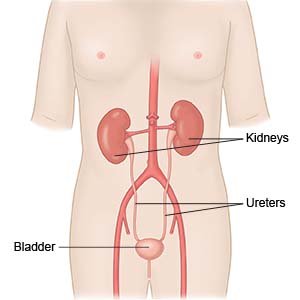Cystoscopy
Medically reviewed by Drugs.com. Last updated on Aug 4, 2025.
AMBULATORY CARE:
A cystoscopy
is a procedure to look inside your urethra and bladder using a cystoscope. A cystoscope is a small tube with a light and magnifying camera on the end. The procedure is used to diagnose and treat conditions of the bladder, urethra, or prostate. Your healthcare provider may also do a ureteroscopy during a cystoscopy. A ureteroscopy is a procedure to look inside your ureters and kidneys.
 |
Prepare for your cystoscopy:
Your healthcare provider will talk to you about how to prepare for your procedure. He or she will tell you what medicines to take and not to take on the day of your procedure. You may need to stop taking medicines such as anticoagulants, aspirin, and ibuprofen several days before your procedure. Your provider may tell you stop eating after midnight the night before your procedure. You may be asked to drink a large amount of liquids before your procedure. Arrange for a ride home after your procedure. You will not be allowed to drive yourself home.
During your cystoscopy:
- You may be given general anesthesia to keep you asleep and pain free during your procedure. Your healthcare provider may instead use local anesthesia. It is put into your urethra and bladder. You will not feel pain, but you may be able to feel some pressure during your procedure. With local anesthesia, you may feel burning or need to urinate when the cystoscope is put in and removed.
- If you are female, you will be placed on your back and your feet may be placed in stirrups. If you are male, you will be placed on your back or in a sitting position. The cystoscope will be placed through your urethra and into your bladder. The urologist will look at the walls of your urethra as the scope goes through to your bladder. Your bladder will be filled with liquid so your urologist can see the inside of your bladder more clearly. Tools may be inserted through the cystoscope to treat any problems in your urethra or bladder. Your provider may also take a sample of tissue and send it to a lab for tests.
After your cystoscopy:
After you are fully awake, you will go home. You may see small amounts of blood in your urine. This is normal. It is also normal to have an increased need to urinate. You may also have burning or mild discomfort in your bladder or kidney area when you urinate. If you had general anesthesia, it may take at least 24 hours before you feel like your usual self.
Risks of a cystoscopy:
You may bleed more than expected or develop an infection. Your urethra, bladder, or ureters may get damaged during your procedure. You may have abdominal pain. Swelling caused by the cystoscopy may cause a blockage or slow urine flow.
Related medications
Seek care immediately if:
- Your urine turns from pink to red, or you have clots in your urine.
- You cannot urinate and your bladder feels full.
- You have severe pain.
Contact your healthcare provider or urologist if:
- Your pain or burning during urination becomes worse or lasts longer than 1 day.
- Your urine stays pink for longer than 1 day.
- You have a fever and chills.
- You urinate less than usual, or still feel like you have to urinate after you use the bathroom.
- You have questions or concerns about your condition or care.
Medicines:
You may be given any of the following:
- Antibiotics help treat or prevent a bacterial infection.
- Acetaminophen decreases pain and fever. It is available without a doctor's order. Ask how much to take and how often to take it. Follow directions. Read the labels of all other medicines you are using to see if they also contain acetaminophen, or ask your doctor or pharmacist. Acetaminophen can cause liver damage if not taken correctly.
- Take your medicine as directed. Contact your healthcare provider if you think your medicine is not helping or if you have side effects. Tell your provider if you are allergic to any medicine. Keep a list of the medicines, vitamins, and herbs you take. Include the amounts, and when and why you take them. Bring the list or the pill bottles to follow-up visits. Carry your medicine list with you in case of an emergency.
Self-care:
- Drink liquids as directed. Your healthcare provider may recommend that you drink 6 to 8 eight-ounce cups of water every day for 2 days after your procedure.
- Apply a warm, damp washcloth over your urethral opening. This may help to relieve discomfort.
- Ask when you can return to regular daily activities. Your healthcare provider may recommend that you rest after your procedure.
- Do not have sex until your healthcare provider tells you it is okay. Sex may increase your risk for a urinary tract infection.
Follow up with your healthcare provider as directed:
Write down your questions so you remember to ask them during your visits.
© Copyright Merative 2025 Information is for End User's use only and may not be sold, redistributed or otherwise used for commercial purposes.
The above information is an educational aid only. It is not intended as medical advice for individual conditions or treatments. Talk to your doctor, nurse or pharmacist before following any medical regimen to see if it is safe and effective for you.
Further information
Always consult your healthcare provider to ensure the information displayed on this page applies to your personal circumstances.
